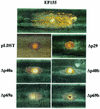Contribution of protein p40 to hypovirus-mediated modulation of fungal host phenotype and viral RNA accumulation
- PMID: 12097588
- PMCID: PMC136391
- DOI: 10.1128/jvi.76.15.7747-7759.2002
Contribution of protein p40 to hypovirus-mediated modulation of fungal host phenotype and viral RNA accumulation
Abstract
The papain-like protease p29, derived from the N-terminal portion of the hypovirus CHV1-EP713-encoded open reading frame (ORF) A polyprotein, p69, was previously shown to contribute to reduced pigmentation and sporulation by the infected host, the chestnut blight fungus Cryphonectria parasitica, while being dispensable for virus replication and attenuation of fungal virulence (hypovirulence). We now report that deletion of the C-terminal portion of p69, which encodes the highly basic protein p40, resulted in replication-competent mutant viruses that were, however, significantly reduced in RNA accumulation. While the Delta p40 mutants retained the ability to confer hypovirulence, Delta p40-infected fungal strains produced more asexual spores than strains infected with either wild-type CHV1-EP713 or a Delta p29 mutant virus. As observed for Delta p29-infected colonies, pigment production was significantly increased in Delta p40-infected fungal strains relative to that in CHV1-EP713-infected strains. Virus-mediated suppression of laccase production was not affected by p40 deletion. A gain-of-function analysis was employed to map the p40 symptom determinant to the N-terminal domain, encompassing p69 amino acid residues Thr(288) to Arg(312). Evidence that the gain of function was due to the encoded protein rather than the corresponding RNA sequence element was provided by introducing frameshift mutations on either side of the activity determinant domain. Moreover, restoration of symptoms correlated with increased accumulation of viral RNA. These results suggest that p40 indirectly contributes to virus-mediated suppression of fungal pigmentation and conidiation by providing an accessory function in hypovirus RNA amplification. A possible role for p40 in facilitating ORF B expression and the relationship between hypovirus RNA accumulation and symptom expression are discussed.
Figures







Similar articles
-
Hypovirus papain-like protease p29 functions in trans to enhance viral double-stranded RNA accumulation and vertical transmission.J Virol. 2003 Nov;77(21):11697-707. doi: 10.1128/jvi.77.21.11697-11707.2003. J Virol. 2003. PMID: 14557655 Free PMC article.
-
Synergism between a mycoreovirus and a hypovirus mediated by the papain-like protease p29 of the prototypic hypovirus CHV1-EP713.J Gen Virol. 2006 Dec;87(Pt 12):3703-3714. doi: 10.1099/vir.0.82213-0. J Gen Virol. 2006. PMID: 17098988
-
Papain-like protease p29 as a symptom determinant encoded by a hypovirulence-associated virus of the chestnut blight fungus.J Virol. 1993 Nov;67(11):6513-21. doi: 10.1128/JVI.67.11.6513-6521.1993. J Virol. 1993. PMID: 8411354 Free PMC article.
-
Hypoviruses and chestnut blight: exploiting viruses to understand and modulate fungal pathogenesis.Annu Rev Genet. 2001;35:1-29. doi: 10.1146/annurev.genet.35.102401.085929. Annu Rev Genet. 2001. PMID: 11700275 Review.
-
Biological control of chestnut blight with hypovirulence: a critical analysis.Annu Rev Phytopathol. 2004;42:311-38. doi: 10.1146/annurev.phyto.42.040803.140325. Annu Rev Phytopathol. 2004. PMID: 15283669 Review.
Cited by
-
Variations in hypovirus interactions with the fungal-host RNA-silencing antiviral-defense response.J Virol. 2012 Dec;86(23):12933-9. doi: 10.1128/JVI.00961-12. Epub 2012 Sep 19. J Virol. 2012. PMID: 22993160 Free PMC article.
-
Molecular characterization of a novel mitovirus from the edible fungus Pleurotus pulmonarius.Arch Virol. 2025 May 16;170(6):132. doi: 10.1007/s00705-025-06310-9. Arch Virol. 2025. PMID: 40379999
-
A novel bipartite double-stranded RNA Mycovirus from the white root rot Fungus Rosellinia necatrix: molecular and biological characterization, taxonomic considerations, and potential for biological control.J Virol. 2009 Dec;83(24):12801-12. doi: 10.1128/JVI.01830-09. Epub 2009 Oct 14. J Virol. 2009. PMID: 19828620 Free PMC article.
-
Use of cDNA microarrays to monitor transcriptional responses of the chestnut blight fungus Cryphonectria parasitica to infection by virulence-attenuating hypoviruses.Eukaryot Cell. 2003 Dec;2(6):1253-65. doi: 10.1128/EC.2.6.1253-1265.2003. Eukaryot Cell. 2003. PMID: 14665460 Free PMC article.
-
Hypovirulence of Sclerotium rolfsii Caused by Associated RNA Mycovirus.Front Microbiol. 2016 Nov 10;7:1798. doi: 10.3389/fmicb.2016.01798. eCollection 2016. Front Microbiol. 2016. PMID: 27891121 Free PMC article.
References
-
- Anagnostakis, S. L. 1982. Biological control of chestnut blight. Science 215:466-471. - PubMed
-
- Asamizu, T., D. Summers, M. B. Motika, J. V. Anzola, and D. L. Nuss. 1985. Molecular cloning and characterization of the genome of wound tumor virus: a tumor-inducing plant reovirus. Virology 144:398-409. - PubMed
-
- Baltimore, D. 1969. The replication of picornaviruses, p. 101-176. In H. B. Levy (ed.), The biochemistry of viruses. Marcel Dekker, New York, N.Y.
-
- Bavendamm, W. 1928. Uber das vorkommen und den Nachweis von Oxydasen bei holzzerstorenden Pilzen. Z. Pflanzenkr. Pflanzenschutz 38:257-276.
-
- Chen, B., G. H. Choi, and D. L. Nuss. 1994. Attenuation of fungal virulence by synthetic infectious hypovirus transcripts. Science 264:1762-1764. - PubMed
Publication types
MeSH terms
Substances
Grants and funding
LinkOut - more resources
Full Text Sources
Research Materials

